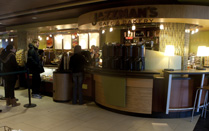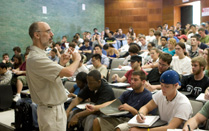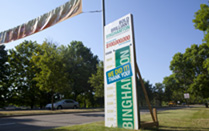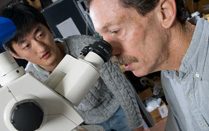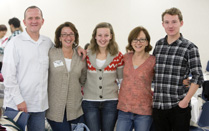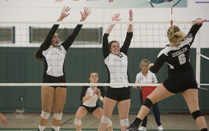Binghamton University President Harvey Stenger's quarterly report - Dec. 31, 2012
As we put the final touches on my first year as Binghamton University president, I want to congratulate the University community for a successful year. The previous Quarterly Reports have detailed many of our achievements as well as a number of ongoing projects that have involved the University’s faculty, staff, students, community members, and friends and supporters. It is clear from looking at this record that Binghamton University is an active, exciting place at which to learn and work, and that the future ahead of us is very bright.
The past three months have been extremely busy for the campus. In this report, you will learn of our efforts to support graduate education through a new Doctoral Fellowship program, about progress on the many construction projects under way across campus, about our Bold.Brilliant.Binghamton campaign celebration, about how the campus came together for “De-stress December” and much, much more. Don’t be misled by the fact that this report highlights these achievements in pages dedicated to each division — academic affairs, student affairs, administration, external affairs, research and athletics. As will be evident in this report, almost all of our successes are group efforts that involve many individuals working across divisional and disciplinary lines.
Our activities also have an impact that extends outside the campus. Binghamton students take their skills and talents with them when they graduate. Our faculty conduct research that influences the way business and industry work, and engage in scholarship that transforms our understanding of the world around us. And of course, the University itself has a real and meaningful economic impact in the Southern Tier and beyond — over $1.2 billion in New York state in 2011, according to the University’s most recent economic impact report.
Binghamton University has been working very closely with Gov. Andrew Cuomo and the Southern Tier Regional Economic Development Council (STREDC), which was created to develop public-private partnerships to rebuild the state’s economy. In early December, the governor was in Binghamton to get an update on the STREDC’s work. During his visit, he announced that I was being appointed co-chair of the council, where I will be working alongside Tom Tranter, president and CEO of Corning Enterprises.
The regional economic development councils were formed to compete for funding through the New York State Consolidated Funding Application. Last year, the STREDC received nearly $50 million from the competitive process, which funded 55 separate projects that created or retained 2,460 jobs in the Southern Tier. This year, we’re thrilled to have been selected as one of the “best performers” and we have been awarded $91.1 million in the second round of funding. Binghamton University is a key actor in a number of the STREDC projects that will now move forward with this funding, including the Southern Tier High Technology Incubator and BAE’s hybrid electronic propulsion system.
In the past year, private investment reached more than $132 million, representing a return on investment of more than $2.50 for every dollar invested by the state. We will continue with the same approach, and will leverage funds from private investors with state resources, thereby multiplying the impact of the $91.1 million.
Now let’s take a look at what we’ve been doing since our last report:
Moving forward on the University Road Map
The nine Road Map teams have been meeting regularly over the past three months and have produced vision statements that encompass both the medium- and long-term. These five- and 20-year statements will establish a foundation for our future direction.
The teams also have prepared specific proposals (the “3-I’s” — initiatives, innovations and ideas). All told there are 176 different proposals, which are available on the Road Map website (just click on a team name on the left and then click on team proposals to see each team’s proposals). During the winter break, the vice presidents and the Road Map Steering Committee will review the proposals and begin ranking them. Beginning in February, Provost Donald Nieman and I will review their recommendations, looking for the most promising proposals as we begin preparing our budget for the 2013-14 fiscal year.
Before making any final decisions, the entire campus will have the opportunity to review our proposed plan. Subsequent budgets beginning in 2014 will consider proposals that could not be funded in the first year. In the end, I expect that some proposals will require continuous investments of resources, but will have a long-term payoff; others will require one-time funding but will move us quickly along our Road Map. Still others may not require any initial funding, but will instead spark a conversation and further study, with the possibility of investments in the future.
From what I have seen so far, the teams have produced a very broad range of proposals. Some are very large, even visionary changes; others are very specific and highly detailed. The teams have critically examined virtually every aspect of our activities, from our international education to philanthropic outreach, to the uses of technology and the future of our athletic teams. While it is too early to say how these proposals will be ranked or how they will complement each other, I want to commend the team members for their personal dedication and the comprehensiveness of their work.
Overall, I believe that the Road Map process has been a valuable exercise for the campus — not only because it is resulting in a lot of good ideas, but also because it has brought together a lot of smart people who are invested in, and excited about, the future of the University.
Student involvement in University Forums
This same spirit of commitment to the University was present during three campus forums I held during the fall semester. The forums helped gather student opinions and ideas on topics that are part of our Road Map process — Diversity and Inclusiveness, Community Engagement, and Personal Safety. Between 30 and 50 students attended each meeting, which were organized and facilitated by Residential Life staff on behalf of the respective Road Map teams. I was especially interested in sponsoring these events because I believe it is important to get the students’ perspectives with regard to issues that directly impact them.
The first forum was facilitated by University Affirmative Action Officer Valerie Hampton and Educational Opportunity Program (EOP) Director Randall Edouard, co-chairs of the Diversity and Inclusiveness Road Map Team. Students wrestled with several questions designed to elicit ideas about how to increase conversations between the various cultures and groups to which students identify, to ascertain perceptions about the campus culture, and to seek input into ideas that can strengthen the University’s commitment to diversity and inclusiveness.
While the general sense of the group was that Binghamton is a campus that encourages conversations and interactions among groups, there is still much more that can be done. It was with this thought in mind that I encouraged each of the participants — just as I am encouraging the readers of this report, to engage in what I call “a random act of inclusiveness.” I believe that if each of us can step out of our comfort zone and have a real conversation with people from a different background, it will truly transform our campus.
The second forum, facilitated by Associate Professor of Public Administration Pamela Mischen and Assistant Vice President for Government Relations Terrence Kane, focused on community engagement. Students sought to find ways to move the campus from community interaction through short-term connections between the campus and community groups, to true engagement, which they defined as long-term and sustaining.
Students spoke about the need to develop a greater student presence in the communities around the campus, as well as the need to provide opportunities for community members to engage with the campus, for example, by having members of community organizations meet with students on campus, or by establishing community advisors for student groups. Several students spoke about the transformational impact of community service and experiential learning that occurred as a result of working with community members following the floods last year. I was impressed by the breadth of student engagement that already exists, as well as by the vision of students who aim to make Binghamton the most community-engaged school in SUNY and in the top 10 in the nation.
The third forum addressed issues of personal safety and was facilitated by University Chief of Police Tim Faughnan, Vice President for Strategic and Fiscal Planning Michael McGoff and Vice President for Administration James Van Voorst, along with Personal Safety Advisory Committee Chair (PSAC) William Ziegler and three student representatives from the committee.
Overall, students perceive the University as a safe place, though there is more that must be done to educate students about their role in maintaining a safe environment, as well as working with the communities around campus to increase student safety. Several speakers indicated there is a need to develop a safety-conscious culture on campus, and offered a number of specific suggestions ranging from increasing the number of Late Nite programs to rerouting traffic on campus to enhance pedestrian safety. I’m certain that many of these ideas will find their way into the recommendations of the Road Map Infrastructure Team.
Celebrating Bold.Brilliant.Binghamton
In October the annual Homecoming events included a special celebration of the conclusion of Bold.Brilliant.Binghamton — The Campaign for Binghamton University. This campaign, the second comprehensive gifts campaign in the University’s history, raised $101.2 million to enhance educational opportunities for students, foster innovative research by faculty and strengthen the University for years to come. The campaign easily met its initial goal of $95 million before we set the bar higher at $100 million, and in the end, more than 30,000 donors participated, more than half of whom had never given previously. This was an ambitious undertaking and I want to thank Campaign Chair Paul Turovsky ’73 for his leadership. This was a difficult campaign carried out in a very challenging economic environment.
The campaign has had a positive impact on all areas of the University, raising more than $45 million to support faculty research and academic programming, as well as $10 million for flexible funding through the Binghamton Fund. Most significantly, the campaign raised $45 million to support student scholarships and educational opportunities, including 102 new scholarships that will help us attract stronger, better students, many of whom would otherwise go to other campuses, or worse, miss out entirely on the chance for a college education.
Recognizing hundreds at Fall Commencement
Fall Commencement 2012, held Dec. 16, in the Events Center, was a great way to close out the semester. I shook the hands of hundreds of graduates as they crossed the stage to receive their degrees, and we honored James Carrigg, retired chairman, chief executive officer and president of New York State Electric & Gas Corporation (NYSEG), with an honorary degree for his long-standing support of Binghamton University.
Carrigg, a founder of the Thomas J. Watson School of Engineering and Applied Science, told the story of how it was “mission impossible” to establishment the school, but then-University President Clifford Clark told his staff, “Let’s not be too hasty.”
After that defining moment, “The community team and the academic team banded together to take on the skeptics in Albany,” said Carrigg. “It took many months and countless trips to Albany to change minds, but again: This was the right thing to do.”
In my second Commencement address as president, I again read a letter to the graduates, discussing the four characteristics that I’ve found in great people and “a great class”: dependability, enjoyability, perspective, and being ‘slightly obsessed.’ Whether their direction is in engineering or art, in government or healthcare, these graduates will need perseverance and dedication to achieve their goals and I encouraged them to “stay dependable, enjoy what you do, keep a wide perspective, and remember that it is OK to be a little obsessed.”
Our student speakers, Jason Loew, who received his doctorate in computer science, and Matthew Comite, who received a bachelor’s degree in human development, reminded their fellow graduates that their time at Binghamton University had provided graduates with necessary skills, but also prepared them for further growth.
“There is a place for each one of us out there,” Loew said. “We will all find our path, and as we each pursue our personal goals, seek out what fulfills your needs and matches your interests. Feed your aspirations. Find out what makes you happy.”
Comite, who received a bachelor’s degree in human development, was the day’s final speaker and received the most enthusiastic ovation from the graduates and guests. He first told the crowd that he has lived his life with a stutter and then gave his classmates three tips that allowed him to succeed at Binghamton University: “Be yourself, find your strengths and play to them, and control your emotions. Do not let them control you.”
Read more about Fall Commencement
That’s a quick summary of my fall semester at Binghamton, and the end of my first year at the University. It has been a fun ride so far, and I can’t wait to get started on the next year.
Sincerely,

Harvey G. Stenger

